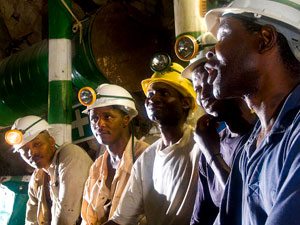
[miningmx.com] – THE road to hell is lined with good intentions, according to the well-worn idiom.
In the case of South Africa’s mining sector, make that a super highway of good ideas gone awry, especially in the realm of its social and labour obligations and as it attempts to comply with the mining charter, and health and safety legislation.
For instance, creating small to medium business enterprises was thought to have been one possible solution to impoverishment around the mines. According to Graham Herbert, a medical doctor and MD of Teba, however, SMEs don’t always have the desired effects.
“SMEs are often supply-led not demand-led. You can learn to make bricks or weld at the mine premises, but when mineworkers move into the outlying areas, no-one wants to buy bricks,’ Herbert says. “Who wants burglar bars in Xai-Xai?’
Herbert’s contention is that there’s oftentimes a disconnect between mining company management and employees that a plugged-in, practical organisation can bridge.
Enter Teba, the former gold and platinum-sponsored recruitment agency that was taken private by former trade unionist, James Motlatsi, in 2005. After nine years playing bass to the mining sector’s lead guitar, however, Herbert wants to enter the frontline debate.
It’s certainly an opportunistic move in the aftermath of the Marikana tragedy two years ago, as well as the subsequent Farlam Commission, which have brought the issue of mineworker living standards to popular consciousness.
But it’s also a necessary when one considers some of the facts.
For example, there’s R5bn in unpaid provident and pensions benefits owned to mineworkers that Teba can reach. And in the future, there may be a host of silicosis sufferers due restitution but who have returned to some pretty remote villages and will be hard to find.
“Our key strength is our network,’ says Herbert. “Every mineworker in the gold and platinum industry knows where there’s a Teba office.’ Teba has 100-odd offices in labour sending areas and on all the mines representing about 350,000 current mine workers.
It also claims to understand mineworker needs in the labour-sending areas – Mozambique, the Eastern Cape and Lesotho – as a result of this historic reach, hence the observation that knowing how to grow cabbages is more important than making bricks in the rural areas. Or that mineworkers don’t necessarily want to own a house near the mine which is a feature of many labour and social plans.
A radio campaign in the Eastern Cape province attracted 100,000 applications from people claiming they were owed some of the R5bn, roughly half of the 200,000 thought to be out of pocket. It’s unlikely all applications will be valid, but it’s a start.
As pertinent is the requirement for better coordination of labour and social plans.
It’s not enough for a mining company to donate a sum of money to the community without having to consider whether the municipality has the skills to deploy the capital and whether, in fact, the project could be better developed in joint venture with another mining company operating nearby.
It’s worth noting at this juncture that some mining companies may find they fail some of the demands of the mining charter on social and labour plans alone. Given the risk of losing the right to mine – the ultimate sanction Government has for mining firms that fail the charter – Herbert’s comments may carry some currency with the miners.
“Because we’ve got offices in labour-sending areas, and we have well known community liaison offices, we are able to understand and match the need with what mining company can offer,’ says Herbert. “Secondly, where producers are too small, Teba can run the whole SLP programme.’
This article first appeared in Finweek.











